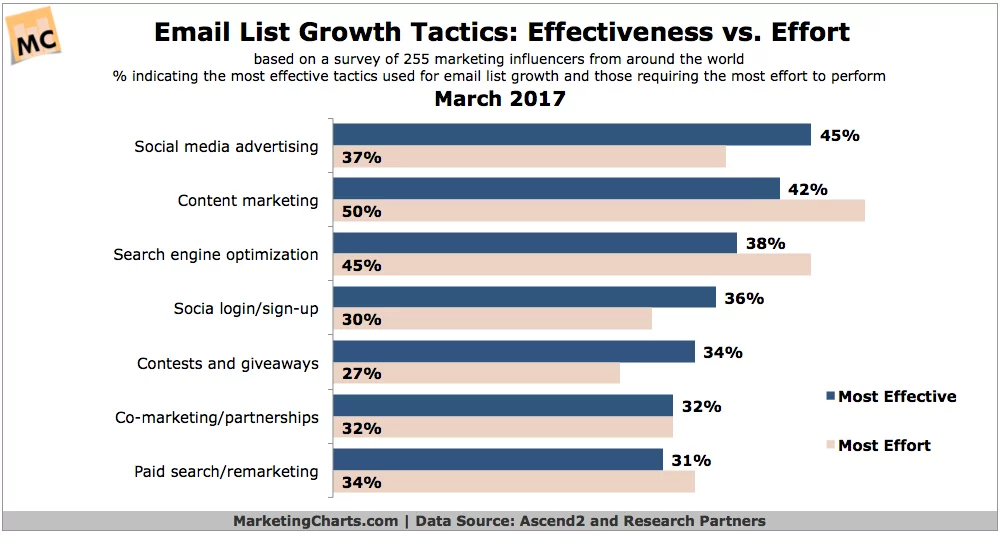In an era with countless social media platforms and messaging apps, people still use email every day. And for any business out there, this is a priceless opportunity to get in front of their target audience.
To achieve success with email marketing, you need a strong database of addresses to send emails to. There are several paths you can go: building your own list, buying it or even renting it.
But which option makes the most sense for a business looking to engage their subscribers and increase conversion rates? Let’s find out.
Three ways to build a B2B email marketing database
Depending on how much time and money you have, there are three ways you can go to build a database of emails.
Building a list
This is the most time-consuming but also the most rewarding option. When you want to build an email list, you collect emails from interested email subscribers in different ways. For example, by getting them to sign up for email newsletters, by offering discounts, lead magnets or something nice and free in return.
While you can build your B2B email database list from scratch and this is often recommended for the best results, there are also the options to buy or rent a list. It is worth mentioning, before you dive in, that we do not recommend either buying or renting an email list for your email marketing campaigns.
Renting an email list
You can rent a list from a list provider; however, you will not see the email list at all. The provider sends out your emails to their own list, and you will only know who is on the list of recipients if they take action by clicking on a link in your email and filling out their details on the landing page.
However, the main benefit here is that your own email system will not see any negative impacts for spam if you send emails to addresses that you have acquired from another party. The benefit is that there is no harm to your sender reputation. The downside is that you never really own a list of email addresses or even get to see it.
Buying an email list
You can buy a list from a reputable email list provider that is based on your buyer persona demographics. In this case, you receive the list as it is and have full access to the information regarding who is on it. You will be able to email and contact the people on the list yourself.

However, it is important to think about the potential consequences of buying an email list for your sender reputation. If you just send out emails to a purchased list without first checking and verifying the list, you may be listed as spam. And even worse, there is a chance that these people are not really your potential customers.
Landing in the spam folder can happen even if you have purchased emails that have been listed as ‘opted in’ since they may not have explicitly given their consent to receive emails from you. Because of this, your email provider may not allow you to send the messages, or you could even end up blacklisted if recipients report you as spam.
Out of all the methods to build a list, this is the most harmful to your deliverability rates and arguably the worst in terms of return on investment.
Business email verification: making sure your list is clean
If you’ve already purchased a list of emails, you can take some precautions to make sure your sender reputation stays safe. The first one is to verify the emails on the list and make sure they’re correct (no typos or errors) and valid (they still exist).
One of the best things that you can do to reduce the negative impacts of buying an email list for your business-to-business database list is to ensure the list is clean before you start sending marketing emails to the addresses on it.
You can do this with a verification tool or using a double opt-in process where you first send an email to each address on the list with a link that they can click if they want to be added to your mailing list.
Double opt-in is a good way to ensure that you are only sending emails to people who are actually happy to hear from you. However, the main problem with doing it after purchasing a list is that the people who own the email addresses that are on the list will not have opted in to receive emails from you in the first place, so it’s likely that the number of clicks you are going to get on the verification link will be very low.

Business email validation
Before you send out any emails to addresses on a B2B list you have purchased, it’s important to perform a list cleanse. Start by looking out for anything that sticks out immediately such as typos and spelling mistakes, duplicate email addresses or obvious fake names.
Then, run your list through an email list cleaning service such as Bouncer to ensure data hygiene. This will help you remove anything like spam traps, fake email addresses, or email addresses that are no longer in existence so you can increase your chances of email marketing success.
Once you have done this, it is time to determine what you are going to send as a first email to these people who likely do not know anything about your company at the moment.
The best option is to put together a short and personalized email that touches on any business challenges that they may be facing at the moment, followed by information about how your business can help and something you could offer them if they opted in to receiving more marketing emails from you such as a free tool, checklist, video, or eBook.
Business verification API for building and maintaining your B2B list
Whether you plan to build your B2B email marketing database from scratch or purchase a list of addresses, it’s important to ensure that it is well-maintained over time.
There are several best practices to keep in mind to help you ensure that you are getting the best results from your B2B list and that you’re reaching out to high-quality leads.
Set Standards
Make sure that everybody is aware of the data that they should use for business contact data entry. In many cases, having a name and an email address alone isn’t enough. You need firm demographics, buyer persona information, and other forms of contact in order to get the best results. Ideally, you should have multiple email addresses or contacts for each business that you are targeting.
Monitoring process
It is important to bear in mind that the health of your B2B marketing database might change over time. Due to the process of data decay, your contact list might become less and less effective each month, which is why it is so important to have a solid monitoring plan in place.
Regularly use an email list cleanup and validation checking tool to look out for any inaccurate information such as inactive email addresses that can be flagged and removed or updated. Inaccurate email lists can pose quite the problem for your email deliverability rates as you could have hundreds of emails going out to invalid email addresses.
Build your list
Whether you build your B2B marketing database from the ground up (through something like email newsletters) or started out by purchasing a list, the database needs to be constantly built to ensure that it has current information.
For example, you will need to update your list with new information if the decision-maker at a target company leaves their position or if a target business changes hands to a new owner.
Data decay and why it’s a problem
Email lists tend to get old over time. Every few months or so, a good part of your list will no longer be active, as people stop working at a certain company and delete their address, or they stop using an address altogether.
For your email communications this is a problem, as you could continue messaging them through your email marketing platform. No matter what app you use, it won’t tell you that the address is no longer active.
So, one of the best email marketing tips is to clean up your lists from time to time.
It’s important for B2B marketers to go through and update their contact list, but how often should this be done? The monitoring process should be an ongoing one; regular checking for outdated contact details so that they can be flagged for an update should be something that you are always doing.
However, the main issue is that data decay is a constant problem and can sometimes be harder to identify than you might realize. For example, a contact might set up a new email address but keep their old one active.
Hopefully, they set up forwarding so that they are still receiving any emails that you send, but there is no guarantee of this. Overall, the numbers show that on average, an email list will degrade by over twenty percent on a yearly basis.
Laws and regulations around email list building
The process of creating, purchasing, and using B2B databases may need to be done with careful consideration and observation of certain laws and regulations, depending on where your company is based.

For example, in the European Union and the UK, there is the General Data Protection Regulation or GDPR, which came into effect in May 2018 and changed a few things for B2B marketers.
The GDPR extended previous rules and safeguards for personal information and how and when consumers could be contacted by businesses and extended confidential information protection to businesses. This means that both B2B and B2C marketers need to comply with the same standards.
Specifically, you need to ensure that B2B contacts have opted-in to receive marketing communications from you, which is why sending a confirmation email to give your recipients this chance if you are buying your B2B marketing list is good practice. Along with this, both businesses and consumers have the right to be forgotten by asking marketers to delete their data.
Why you need a reliable and verified B2B database
Your B2B email marketing database might be unreliable and inaccurate in several different ways. This can lead to several issues for your business and marketing team.
For example, prospects might accidentally or unintentionally provide inaccurate contact details; employee turnover in target companies could cause the information to become out of date; business closures, growth, or mergers could mean that your information is no longer a true reflection of the target; or B2B databases are lacking in crucial information about clients and key decision makers.
A high-quality, reliable, and verified list will make a lot of things easier for your marketing team, including avoiding wasting time sending emails to addresses that no longer exist or are no longer in use.
When it comes to building your B2B email marketing list, you may want to start from scratch or buy existing data. Whichever method you choose, ensuring that your list is accurate and valid is crucial.
Wrapping up
Email is one of the most effective digital marketing channels there is. However, there are some rules if you want successful email marketing campaigns – and your email marketing database is the start. Keep your lists clean and always monitor for invalid addresses and no matter how you obtained your lists, you should see good engagement rates and overall results.
Sign up for Bouncer today and watch as we validate hundred of thousands of email addresses in front of your eyes. With the best accuracy in the verification game, GDPR and SOC2 compliance and more, Bouncer is your reliable partner of choice.
Frequently asked questions
What is the best method to build a B2B email list?
Out of the three mentioned above (building, buying and renting), building is the best method if you want success in the long run. Buying a list may seem like a shortcut to reaching your business goals, but you could be at a risk of high spam complaints.
How often should I clean up and verify my email lists?
It depends on how quickly your list is growing and how many emails you add every day. However, verifying your lists with Bouncer every few months is a good practice.
What is the main difference between a B2B and B2C email marketing database?
In a B2B email marketing database, you’re going to have many more business emails registered to a specific company. As soon as someone leaves a company, their email is no longer active. On the other hand, B2C email databases comprise of personal emails which usually stay active for longer.


